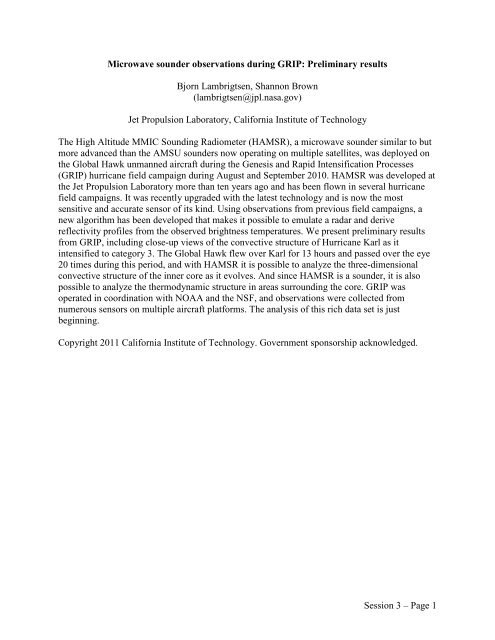65th IHC Booklet/Program (pdf - 4.9MB) - Office of the Federal ...
65th IHC Booklet/Program (pdf - 4.9MB) - Office of the Federal ...
65th IHC Booklet/Program (pdf - 4.9MB) - Office of the Federal ...
Create successful ePaper yourself
Turn your PDF publications into a flip-book with our unique Google optimized e-Paper software.
Microwave sounder observations during GRIP: Preliminary results<br />
Bjorn Lambrigtsen, Shannon Brown<br />
(lambrigtsen@jpl.nasa.gov)<br />
Jet Propulsion Laboratory, California Institute <strong>of</strong> Technology<br />
The High Altitude MMIC Sounding Radiometer (HAMSR), a microwave sounder similar to but<br />
more advanced than <strong>the</strong> AMSU sounders now operating on multiple satellites, was deployed on<br />
<strong>the</strong> Global Hawk unmanned aircraft during <strong>the</strong> Genesis and Rapid Intensification Processes<br />
(GRIP) hurricane field campaign during August and September 2010. HAMSR was developed at<br />
<strong>the</strong> Jet Propulsion Laboratory more than ten years ago and has been flown in several hurricane<br />
field campaigns. It was recently upgraded with <strong>the</strong> latest technology and is now <strong>the</strong> most<br />
sensitive and accurate sensor <strong>of</strong> its kind. Using observations from previous field campaigns, a<br />
new algorithm has been developed that makes it possible to emulate a radar and derive<br />
reflectivity pr<strong>of</strong>iles from <strong>the</strong> observed brightness temperatures. We present preliminary results<br />
from GRIP, including close-up views <strong>of</strong> <strong>the</strong> convective structure <strong>of</strong> Hurricane Karl as it<br />
intensified to category 3. The Global Hawk flew over Karl for 13 hours and passed over <strong>the</strong> eye<br />
20 times during this period, and with HAMSR it is possible to analyze <strong>the</strong> three-dimensional<br />
convective structure <strong>of</strong> <strong>the</strong> inner core as it evolves. And since HAMSR is a sounder, it is also<br />
possible to analyze <strong>the</strong> <strong>the</strong>rmodynamic structure in areas surrounding <strong>the</strong> core. GRIP was<br />
operated in coordination with NOAA and <strong>the</strong> NSF, and observations were collected from<br />
numerous sensors on multiple aircraft platforms. The analysis <strong>of</strong> this rich data set is just<br />
beginning.<br />
Copyright 2011 California Institute <strong>of</strong> Technology. Government sponsorship acknowledged.<br />
Session 3 – Page 1
















